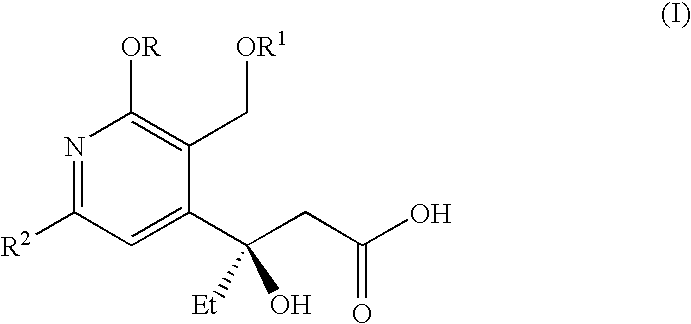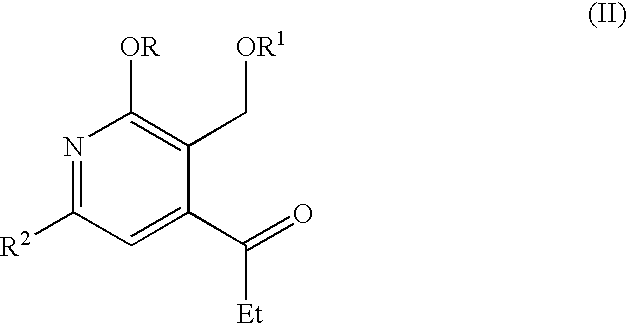Processes for the production of useful intermediates
- Summary
- Abstract
- Description
- Claims
- Application Information
AI Technical Summary
Problems solved by technology
Method used
Image
Examples
example 1
Synthesis of 2-methoxy-isonicotinonitrile
[0225]A stirred suspension of 17.86 g NaOMe (330.7 mmol, 1.22 eq) in 95 mL acetonitrile was cooled to 0° C. and a solution of 37.56 g 2-chloro-4-cyano pyridine (8, 271.1 mmol) in 225 mL acetonitrile was added over 45 min. Stirring was continued at room temperature for 23 h until less than 4% (area) starting material were detected by HPLC. 11.1 g potassium dihydrogen phosphate (81.56 mmol, 0.30 eq) were added at 0° C. and stirring was continued for 3 h at room temperature. The reaction mixture was then evaporated to dryness in a rotary evaporator (40° C. / 10 mbar) yielding the crude product (64.94 g, 179% by weight) as a brown solid. 64.94 g crude product were extracted with 900 mL toluene for 18 h at reflux temperature using a soxhlet extraction apparatus yielding the title product (25.65 g, 71% by weight) as an orange solid.
[0226]Mp: 98° C.;
[0227]1H NMR (300 MHz, CDCl3): δ 8.31 (d, 1H, J=5.1 Hz), 7.07 (dd, 1H, J=5.1 Hz, J=1.2 Hz), 6.99 (br. s...
example 2
Synthesis of 1-(2-methoxy-pyridin-4-yl)-propan-1-one
[0228]A stirred suspension of 25.44 g of 2-methoxy-isonicotinonitrile as obtained in Example 1 (189.7 mmol) in 380 mL TBME was cooled to 0° C. and 114 mL ethyl magnesium chloride in THF (2.0 M, 228.0 mmol, 1.20 eq) were added within 45 min. Stirring was continued at 0° C. After 3 h 40 min, additional 5 mL ethyl magnesium chloride in THF (2.0 M, 10.0 mmol, 0.05 eq) were added at 0° C. The reaction was monitored by HPLC. After 4.5 h (4Cl and 500 mL brine, dried over 50 g Na2SO4 (30 min) and filtered. The filter cake was washed with 100 mL toluene. After evaporation of solvent in a rotary evaporator (40° C. / 10 mbar), the title compound (28.64 g, 91% by weight) was obtained as an orange solid.
[0229]Mp: 38° C.;
[0230]1H NMR (300 MHz, CDCl3): δ 8.30 (d, 1H, J=5.3 Hz), 7.30 (dd, 1H, J=5.3 Hz, J=7.18 (br. s, 1H), 3.98 (s, 3H), 2.96 (q, 2H, J=7.2 Hz), 1.22 (t, 3H, J=7.2 Hz) ppm
example 3
Synthesis of 4-(2-ethyl-[1,3]dioxan-2-yl)-2-methoxy-pyridine
[0231]To a stirred solution of 38.23 g of 1-(2-methoxy-pyridin-4-yl)-propan-1-one (231.4 mmol) as obtainable from Example 2 in 575 mL toluene were added 100 mL 1,3-propandiol (1.39 mol, 6.0 eq), 473 μL sulfuric acid (4.63 mmol, 0.02 eq) and 889 mg para-toluene sulfonic acid monohydrate (4.63 mmol, 0.02 eq). The reaction mixture was heated for 72 h (NMR control: 3 were added and the phases were separated. The organic phase was washed twice with 250 mL, in total with 500 mL brine and was then dried over 50 g Na2SO4 (30 min) and filtered. The filter cake was washed with 100 mL toluene. After evaporation of solvent in a rotary evaporator (50° C. / 10 mbar), the crude product (40.31 g, 78% by weight) was obtained as a brown oil (HPLC purity 93.9% area). Purification was achieved using a high vacuum distillation (bp 95° C. at 0.056 mbar, oil bath temperature 125° C., 40 cm Vigreux column) furnishing the title compound (31.80 g, 142...
PUM
| Property | Measurement | Unit |
|---|---|---|
| Temperature | aaaaa | aaaaa |
| Temperature | aaaaa | aaaaa |
| Temperature | aaaaa | aaaaa |
Abstract
Description
Claims
Application Information
 Login to View More
Login to View More - R&D Engineer
- R&D Manager
- IP Professional
- Industry Leading Data Capabilities
- Powerful AI technology
- Patent DNA Extraction
Browse by: Latest US Patents, China's latest patents, Technical Efficacy Thesaurus, Application Domain, Technology Topic, Popular Technical Reports.
© 2024 PatSnap. All rights reserved.Legal|Privacy policy|Modern Slavery Act Transparency Statement|Sitemap|About US| Contact US: help@patsnap.com










